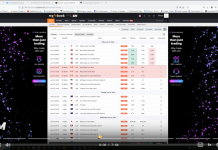 Morgan Stanley is closing EUR shorts. Despite the universally strong reading of the US February labour market report, the USD came under broad selling pressure on Friday evening.
Morgan Stanley is closing EUR shorts. Despite the universally strong reading of the US February labour market report, the USD came under broad selling pressure on Friday evening.
In line with our expectations, high yielding EM currencies have reversed last week’s corrective activities, breaking higher with the help of US real yields remaining benign keeping real yield differentials EM-supportive. However, we have been too pessimistic on the EUR, which gained against most crosses with falling oil prices and increasing EMU rate optimism pushing real and nominal yield differentials into the EUR’s favour. We are closing our EURGBP and EURUSD short positions in our FX Pulse portfolio despite ECB’s Jan Smets insisting that he didn’t signal a coming change to its policy mix last Thursday, because officials concluded that the outlook for inflation hadn’t improved much since December. These comments suggest that the ECB might be further from exiting its massive monetary stimulus than investors had anticipated – Morgan Stanley’s analysts states.
USD weakness
The USD trades increasingly like an oil currency with falling oil prices pushing the USD lower and the EUR higher. This reaction makes sense given the US taking increasingly the role of an oil swing producer with its anti- trust laws preventing its oil industry cooperating with OPEC and others trying to stabilise oil outside its market mechanism.
This is one of many trade ideas which are published on a daily basis by big banks. Try out free trial of FxWatcher service and check out the rest of today’s propositions
Currency reserves have stabilised globally, showing a surprise February rise in China with its sealed capital account helping. Markets are not only nervous about reserve holders allocating some of their incoming reserves away from the USD, the better reserve outlook suggests too that offshore USD liquidity has improved. The narrowing USD cross currency basis against the EUR and especially the JPY points towards better USD offshore liquidity too.
Trade Idea of the Week
We are expecting a moderate risk appetite set back with falling commodity price working as a catalyst. When risk appetite weakens then currencies benefiting from strong foreign balances benefit while currencies in need of capital imports tend to suffer. The AUD falls into the second category due to its AUD3.2trn foreign liabilities, while the SEK enjoys support due to Sweden’s 4.6% current account surplus. The Riksbank watches the ECB carefully. Any indication of the ECB considering tightening pushes Riksbank rate expectations even further as Sweden has progressed well ahead of EMU in its economic cycle. The AUD traders will watch recent China data releases with total social funding coming down from CNY3.7trn in January to CNY1.1 trn in February, suggesting that China’s monetary conditions have tightened which is a AUD negative. This risk to this trade is a rise in iron ore prices.
We like to sell AUD/SEK at 6.89 with a target of 6.60 and stop at 6.97.
















